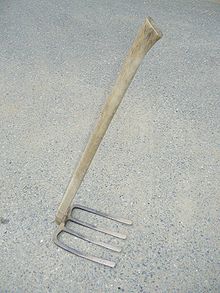Krail
The Krail , Kreil , Kreiel , Krell , Kräuel , even claw , shredders , manure hook , extension rake , four teeth , potato hoe called, is a hand tool for soil cultivation , in particular for loosening and aeration of the soil.
The Krail has a long handle similar to a hoe . At the lower end - like a digging fork - three or four prongs are formed which are bent at right angles . Unlike the Karst of Krail is not as robust worked, and it has a spout (duels) instead of a house . The sequence of movements with the Krail is a "pulling" one and corresponds more to that of a rake than that of a hoe, as is the case with the Karst.
use
The Krail is pulled through the ground or the pile and spreads or loosens the material. With the Krail, similar work can be carried out as with the hoe, the sow tooth (cultivator, or as a machine: cultivator (crumbler) ). Especially when preparing the seedbed , the clods can be broken up with the Krail after digging and the soil can be loosened and aerated. The soil structure is not changed here. The Krail is also suitable for weeding, as it does not cut up weeds , weeds and plant remains, but digs them up.
Except for earthworks, the krail, as the term " dung hook" says, is used to tear apart the dung heaps . It is also used to incorporate manure into the topsoil. Dung hooks are also part of the standard loading of many fire engines (fire engines, rescue vehicles). It is commonly used as an aid to pulling fire rubble apart.
Web links
- Garden tools for digging up, with a sharp-toothed Krail as an illustration , gaertnernohnegift.de
- Catalog with approx. 90 different designs of hoes, crawlers and others , SHW Friedrichstal (PDF file; 2.10 MB)
